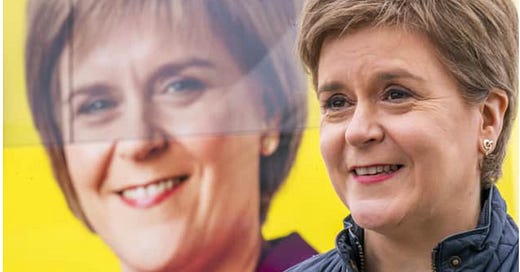Nicola Sturgeon: The mean girl who never grew up
This article was first published in the Scotsman on 3 February 2024 (behind the paywall).
As Nicola Sturgeon wiped away the tears during her testimony at the Covid inquiry earlier this week, I felt a sudden pang of sympathy.
Not for the woman before us, fighting a desperate rear-guard action to save what she could of her legacy – as Alister Jack, the Scottish Secretary, said the next day during his evidence session, Sturgeon could “cry from one eye if she wanted to”. But my heart broke, just a little, for the 16-year-old Nicola Sturgeon.
The introverted, clever working class girl who plucked up all her courage and knocked on the door of Kay Ullrich, a close neighbour in her home village of Dreghorn. Ullrich, an exuberant 40-something, was contesting the Labour-held South Cunninghame seat in the 1987 general election. As she recounts in A Political Life, David Torrance’s biography of Sturgeon, “We were just about to go out leafleting and there she was on the doorstep. ‘Hello, Mrs Ulrich, can I help you with your campaign?’ So she came in, then out she went leafleting.”
But not before she signed up as a member of the SNP’s then youth wing, the Young Scottish Nationalists. Later, Sturgeon recalled the day that changed her life, and arguably Scotland. “You know I could easily not have decided to take that step. But I did, and the rest is history.”
Is she now wishing, as she surveys the debris of her reputation, that she had stayed at home that fateful morning and read a book instead, or jumped on a bus to Irvine to spend hours searching for the perfect eyeshadow? Normal teenage girl things, instead of embarking on a political career that was to end, nearly forty years later, in abject failure.
We will never know. Despite signing a £300,000 contract with Pan McMillan to write her “very personal” memoirs, the world has never seen the real Nicola Sturgeon, and I doubt very much if readers of her autobiography will either. She has spent so long carefully constructing her political personality that it’s not clear if she knows who she is anymore. But recent revelations offer us some clues as to the woman underneath the tailored suits and carefully applied make-up.
Former senior civil servants, men and women trained in the art of diplomacy, recall with a shudder her foul-mouthed phone calls. “I don’t f**ing care about your f**ing process, I just want it done,” was typical of how Sturgeon conducted government business, according to one official I spoke to recently.
Important decisions were taken, not at cabinet, or after lengthy discussion with key officials and ministers, but by the tiny clique that Sturgeon gathered round her. Her chief of staff, Liz Lloyd, a former SNP press officer with no experience outside the party, was one of the most powerful people in the land. She and deputy First Minister John Swinney formed Sturgeon’s kitchen cabinet, and no doubt her husband, Peter Murrell, the SNP’s chief executive until he resigned in disgrace last year, was an honorary member. Everyone else was shut out.
SNP women activists recall how she closed them down with a sneer when they tried to raise concerns about policy or internal party problems. “I have never worked in an environment where such naked intimidation was tolerated or, it could be argued, encouraged,” one woman told me, describing the culture at the top of the SNP under Sturgeon’s leadership.
When one of the SNP’s most popular figures, the MP Joanna Cherry, was the victim of death threats, Sturgeon – ‘feminist to her fingertips’ – did not reach out to her in sympathy. “She doesn’t speak to me,” Cherry later told friends. Joan McAlpine, a highly respected MSP who challenged Sturgeon on gender identity policy, saw her political career destroyed. Even citizens who posed no threat to her, except at the ballot box, were subjected to her sharp tongue. She slandered those who argued against her plans to introduce self-ID as “deeply misogynist, often homophobic, possibly some of them racist as well.”
She cut off former close associates for the sin of disagreeing with her. Mandy Rhodes, Editor of Holyrood magazine, wrote a searing expose of how her long relationship with Sturgeon ended after Mandy asked one question too many.
Under pressure, she lied. She solemnly promised on live TV in August 2021 that she would hand over all her WhatsApp messages to any subsequent inquiry, yet at the time she was regularly deleting them. And who can forget the fake windows painted on the Glen Sannox ferry so that she could go through the pretence of launching it?
But for me the most telling clue to her character came during the Covid inquiry when she said there were times during the pandemic she wished she wasn’t First Minister. It’s hard to imagine Margaret Thatcher thinking the same in the aftermath of the Brighton bombing which killed five of her colleagues. Or the late Alistair Darling as he faced the imminent collapse of RBS and with it the global economy. Leadership requires courage.
Screaming matches when thwarted. Bullying. Mean girl gangs. Gaslighting former friends. Lying when caught out. Fear of responsibility. All typical behaviour of an angry, sullen teenager, not of a mature woman who presented herself to the electorate as a progressive leader in the mould of Hillary Clinton.
There’s a theory that celebrities are emotionally stuck at the same age as when they became famous. Perhaps it applies to politicians too, as it would explain Nicola Sturgeon’s behaviour over the years. Beneath her carefully curated persona was an immature 16-year-old girl, whose sole political aspiration was not social justice, but for Scotland to leave the UK at any cost.
I can’t help thinking if she had decided to go shopping that fateful morning, instead of joining the SNP, Scotland would be in a better place than it is today.




